Critical Review: Pain Management for Elderly Patients with Dementia
VerifiedAdded on 2023/04/21
|13
|4895
|181
Literature Review
AI Summary
This literature review critically appraises primary research articles using the Caldwell framework to identify strengths and weaknesses in studies related to pain assessment and management for elderly patients with dementia. It examines various communication strategies used by nurses, including the use of patient's own words versus pain assessment scales, and the impact of interpersonal communication skills on patient perception of pain management. The review synthesizes findings from multiple studies, highlighting the need for improved pain assessment tools, continuous education and training for healthcare providers, and integrated evidence-based pain management approaches. It also addresses challenges in pain management due to the lack of adequate training and the importance of collaborative working in dementia care facilities. The review concludes by emphasizing the potential benefits of specialist nursing roles in dementia care and the need for further research to explore the impact of communication strategies on neuropsychiatric symptoms.
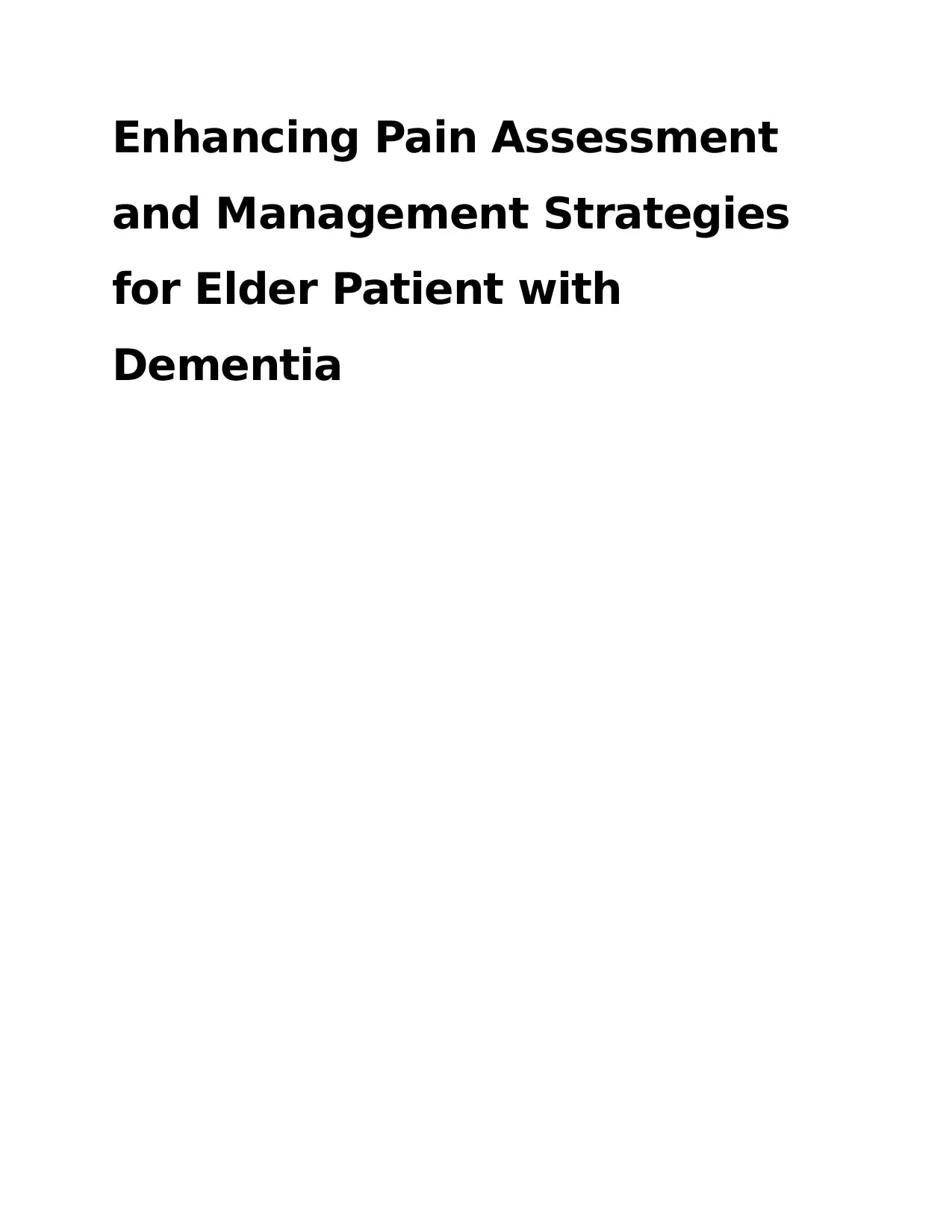
Enhancing Pain Assessment
and Management Strategies
for Elder Patient with
Dementia
and Management Strategies
for Elder Patient with
Dementia
Paraphrase This Document
Need a fresh take? Get an instant paraphrase of this document with our AI Paraphraser
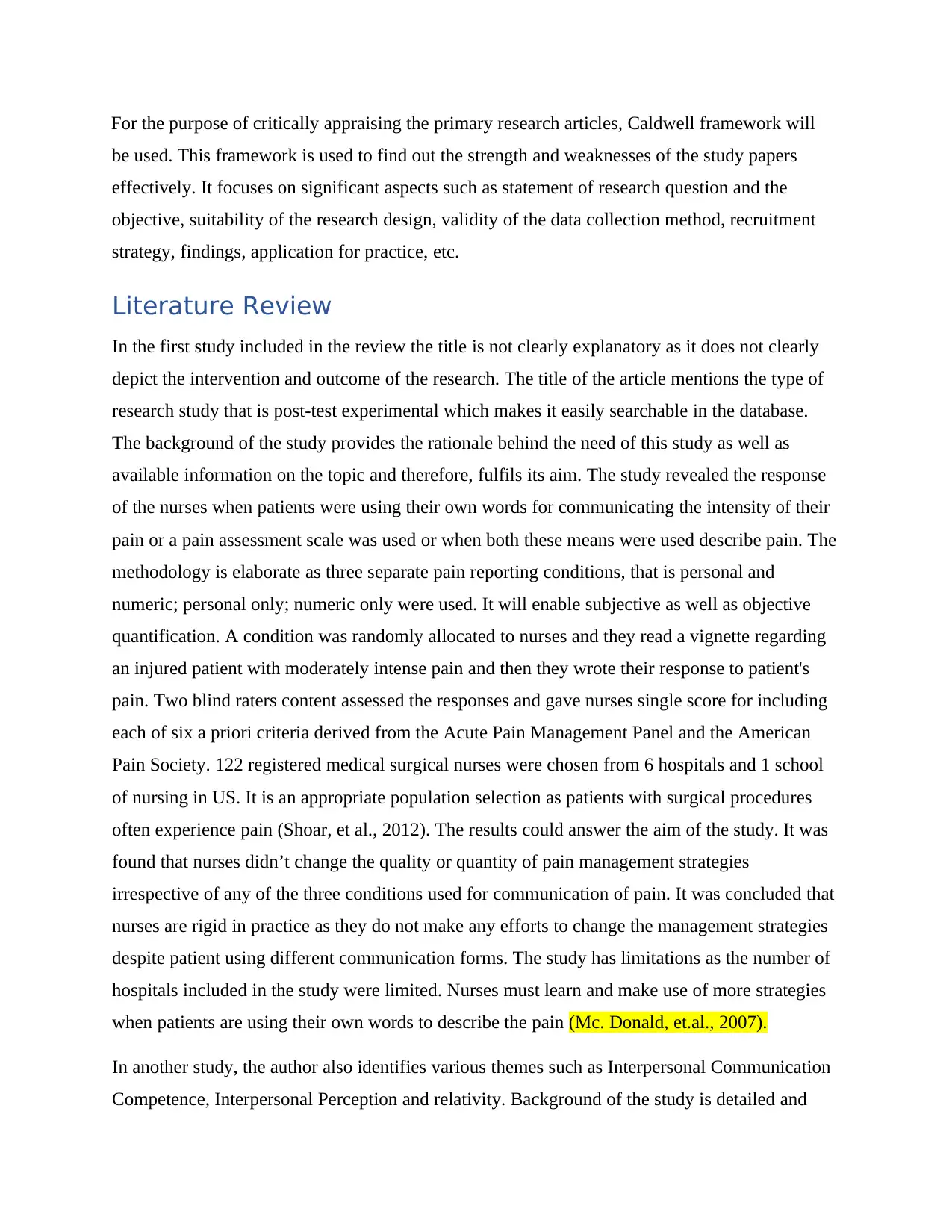
For the purpose of critically appraising the primary research articles, Caldwell framework will
be used. This framework is used to find out the strength and weaknesses of the study papers
effectively. It focuses on significant aspects such as statement of research question and the
objective, suitability of the research design, validity of the data collection method, recruitment
strategy, findings, application for practice, etc.
Literature Review
In the first study included in the review the title is not clearly explanatory as it does not clearly
depict the intervention and outcome of the research. The title of the article mentions the type of
research study that is post-test experimental which makes it easily searchable in the database.
The background of the study provides the rationale behind the need of this study as well as
available information on the topic and therefore, fulfils its aim. The study revealed the response
of the nurses when patients were using their own words for communicating the intensity of their
pain or a pain assessment scale was used or when both these means were used describe pain. The
methodology is elaborate as three separate pain reporting conditions, that is personal and
numeric; personal only; numeric only were used. It will enable subjective as well as objective
quantification. A condition was randomly allocated to nurses and they read a vignette regarding
an injured patient with moderately intense pain and then they wrote their response to patient's
pain. Two blind raters content assessed the responses and gave nurses single score for including
each of six a priori criteria derived from the Acute Pain Management Panel and the American
Pain Society. 122 registered medical surgical nurses were chosen from 6 hospitals and 1 school
of nursing in US. It is an appropriate population selection as patients with surgical procedures
often experience pain (Shoar, et al., 2012). The results could answer the aim of the study. It was
found that nurses didn’t change the quality or quantity of pain management strategies
irrespective of any of the three conditions used for communication of pain. It was concluded that
nurses are rigid in practice as they do not make any efforts to change the management strategies
despite patient using different communication forms. The study has limitations as the number of
hospitals included in the study were limited. Nurses must learn and make use of more strategies
when patients are using their own words to describe the pain (Mc. Donald, et.al., 2007).
In another study, the author also identifies various themes such as Interpersonal Communication
Competence, Interpersonal Perception and relativity. Background of the study is detailed and
be used. This framework is used to find out the strength and weaknesses of the study papers
effectively. It focuses on significant aspects such as statement of research question and the
objective, suitability of the research design, validity of the data collection method, recruitment
strategy, findings, application for practice, etc.
Literature Review
In the first study included in the review the title is not clearly explanatory as it does not clearly
depict the intervention and outcome of the research. The title of the article mentions the type of
research study that is post-test experimental which makes it easily searchable in the database.
The background of the study provides the rationale behind the need of this study as well as
available information on the topic and therefore, fulfils its aim. The study revealed the response
of the nurses when patients were using their own words for communicating the intensity of their
pain or a pain assessment scale was used or when both these means were used describe pain. The
methodology is elaborate as three separate pain reporting conditions, that is personal and
numeric; personal only; numeric only were used. It will enable subjective as well as objective
quantification. A condition was randomly allocated to nurses and they read a vignette regarding
an injured patient with moderately intense pain and then they wrote their response to patient's
pain. Two blind raters content assessed the responses and gave nurses single score for including
each of six a priori criteria derived from the Acute Pain Management Panel and the American
Pain Society. 122 registered medical surgical nurses were chosen from 6 hospitals and 1 school
of nursing in US. It is an appropriate population selection as patients with surgical procedures
often experience pain (Shoar, et al., 2012). The results could answer the aim of the study. It was
found that nurses didn’t change the quality or quantity of pain management strategies
irrespective of any of the three conditions used for communication of pain. It was concluded that
nurses are rigid in practice as they do not make any efforts to change the management strategies
despite patient using different communication forms. The study has limitations as the number of
hospitals included in the study were limited. Nurses must learn and make use of more strategies
when patients are using their own words to describe the pain (Mc. Donald, et.al., 2007).
In another study, the author also identifies various themes such as Interpersonal Communication
Competence, Interpersonal Perception and relativity. Background of the study is detailed and
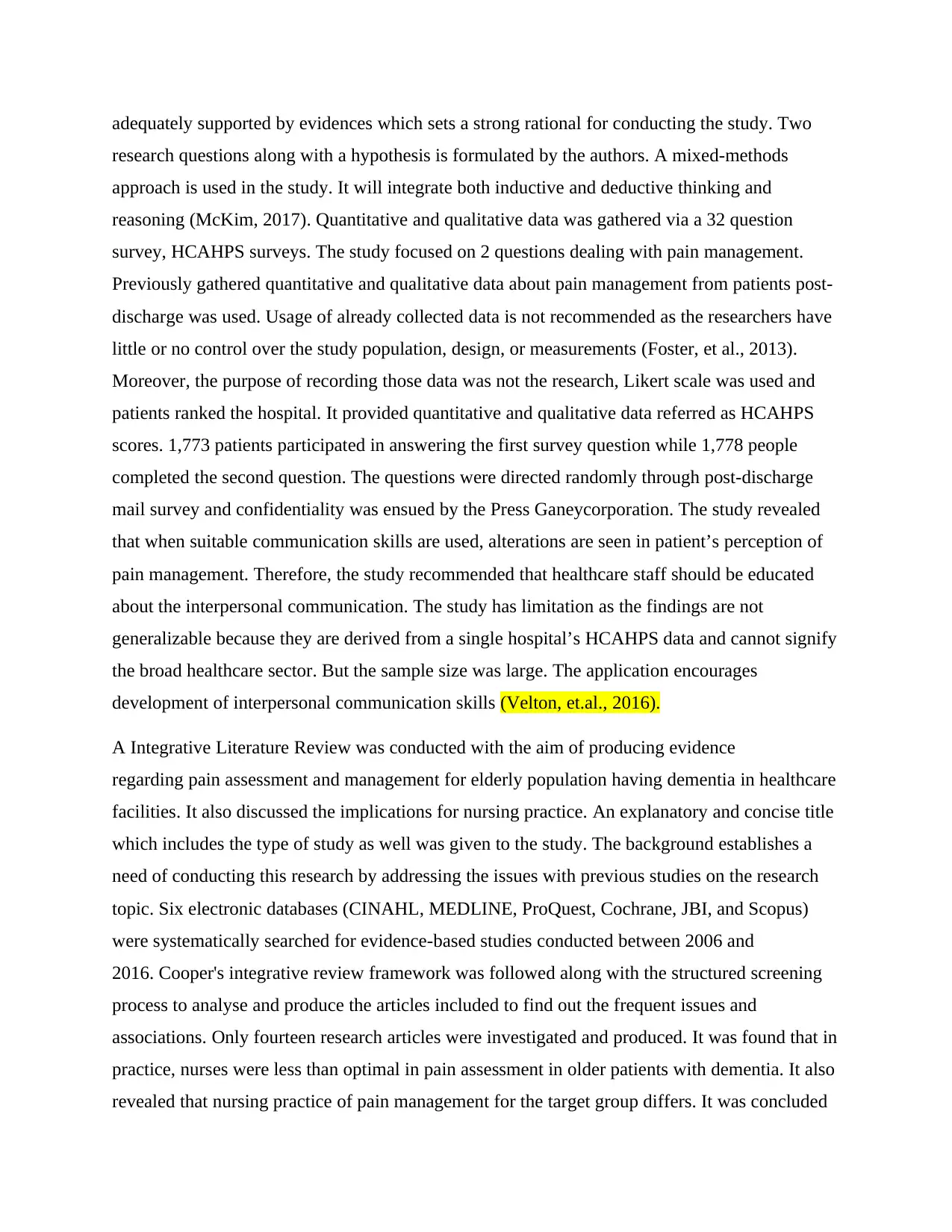
adequately supported by evidences which sets a strong rational for conducting the study. Two
research questions along with a hypothesis is formulated by the authors. A mixed-methods
approach is used in the study. It will integrate both inductive and deductive thinking and
reasoning (McKim, 2017). Quantitative and qualitative data was gathered via a 32 question
survey, HCAHPS surveys. The study focused on 2 questions dealing with pain management.
Previously gathered quantitative and qualitative data about pain management from patients post-
discharge was used. Usage of already collected data is not recommended as the researchers have
little or no control over the study population, design, or measurements (Foster, et al., 2013).
Moreover, the purpose of recording those data was not the research, Likert scale was used and
patients ranked the hospital. It provided quantitative and qualitative data referred as HCAHPS
scores. 1,773 patients participated in answering the first survey question while 1,778 people
completed the second question. The questions were directed randomly through post-discharge
mail survey and confidentiality was ensued by the Press Ganeycorporation. The study revealed
that when suitable communication skills are used, alterations are seen in patient’s perception of
pain management. Therefore, the study recommended that healthcare staff should be educated
about the interpersonal communication. The study has limitation as the findings are not
generalizable because they are derived from a single hospital’s HCAHPS data and cannot signify
the broad healthcare sector. But the sample size was large. The application encourages
development of interpersonal communication skills (Velton, et.al., 2016).
A Integrative Literature Review was conducted with the aim of producing evidence
regarding pain assessment and management for elderly population having dementia in healthcare
facilities. It also discussed the implications for nursing practice. An explanatory and concise title
which includes the type of study as well was given to the study. The background establishes a
need of conducting this research by addressing the issues with previous studies on the research
topic. Six electronic databases (CINAHL, MEDLINE, ProQuest, Cochrane, JBI, and Scopus)
were systematically searched for evidence-based studies conducted between 2006 and
2016. Cooper's integrative review framework was followed along with the structured screening
process to analyse and produce the articles included to find out the frequent issues and
associations. Only fourteen research articles were investigated and produced. It was found that in
practice, nurses were less than optimal in pain assessment in older patients with dementia. It also
revealed that nursing practice of pain management for the target group differs. It was concluded
research questions along with a hypothesis is formulated by the authors. A mixed-methods
approach is used in the study. It will integrate both inductive and deductive thinking and
reasoning (McKim, 2017). Quantitative and qualitative data was gathered via a 32 question
survey, HCAHPS surveys. The study focused on 2 questions dealing with pain management.
Previously gathered quantitative and qualitative data about pain management from patients post-
discharge was used. Usage of already collected data is not recommended as the researchers have
little or no control over the study population, design, or measurements (Foster, et al., 2013).
Moreover, the purpose of recording those data was not the research, Likert scale was used and
patients ranked the hospital. It provided quantitative and qualitative data referred as HCAHPS
scores. 1,773 patients participated in answering the first survey question while 1,778 people
completed the second question. The questions were directed randomly through post-discharge
mail survey and confidentiality was ensued by the Press Ganeycorporation. The study revealed
that when suitable communication skills are used, alterations are seen in patient’s perception of
pain management. Therefore, the study recommended that healthcare staff should be educated
about the interpersonal communication. The study has limitation as the findings are not
generalizable because they are derived from a single hospital’s HCAHPS data and cannot signify
the broad healthcare sector. But the sample size was large. The application encourages
development of interpersonal communication skills (Velton, et.al., 2016).
A Integrative Literature Review was conducted with the aim of producing evidence
regarding pain assessment and management for elderly population having dementia in healthcare
facilities. It also discussed the implications for nursing practice. An explanatory and concise title
which includes the type of study as well was given to the study. The background establishes a
need of conducting this research by addressing the issues with previous studies on the research
topic. Six electronic databases (CINAHL, MEDLINE, ProQuest, Cochrane, JBI, and Scopus)
were systematically searched for evidence-based studies conducted between 2006 and
2016. Cooper's integrative review framework was followed along with the structured screening
process to analyse and produce the articles included to find out the frequent issues and
associations. Only fourteen research articles were investigated and produced. It was found that in
practice, nurses were less than optimal in pain assessment in older patients with dementia. It also
revealed that nursing practice of pain management for the target group differs. It was concluded
⊘ This is a preview!⊘
Do you want full access?
Subscribe today to unlock all pages.

Trusted by 1+ million students worldwide
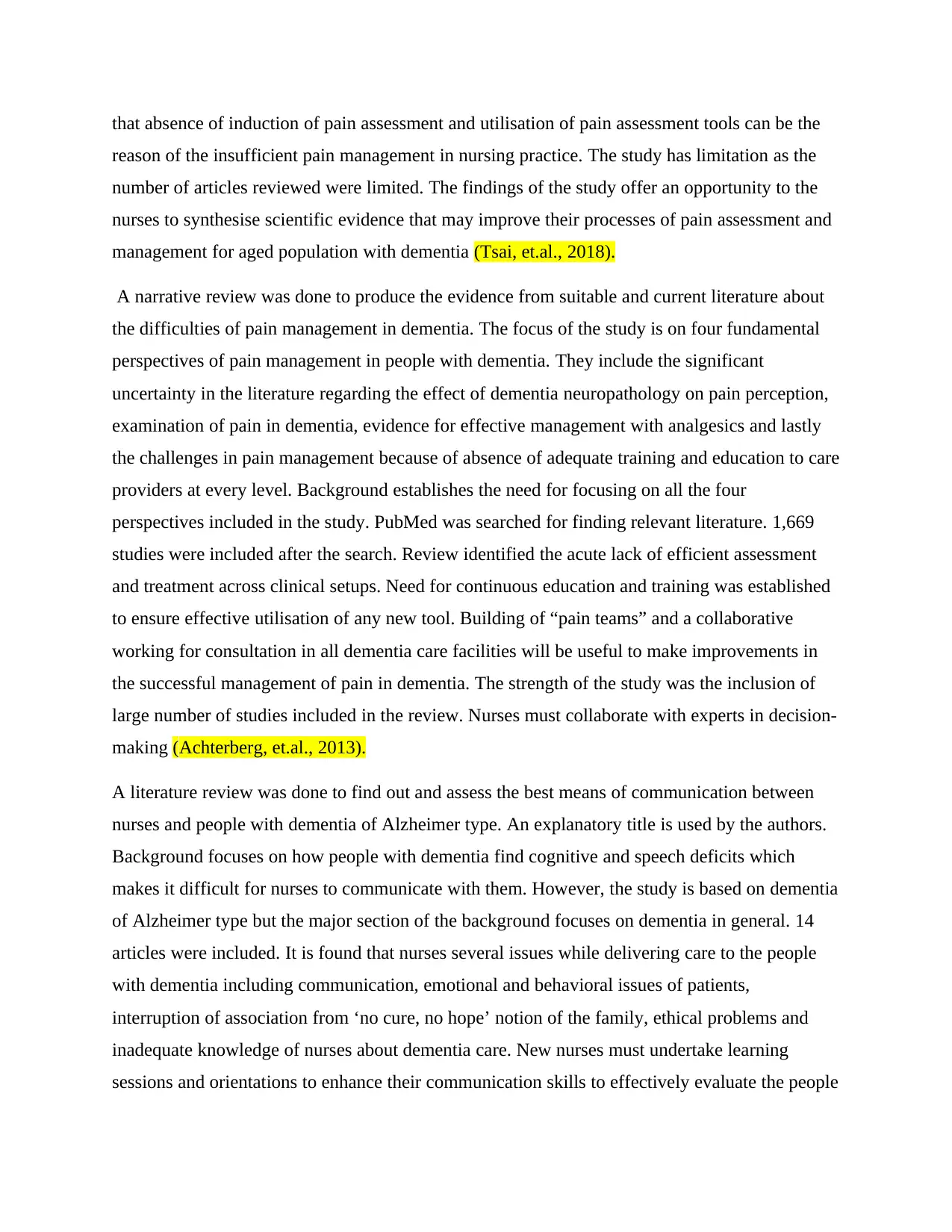
that absence of induction of pain assessment and utilisation of pain assessment tools can be the
reason of the insufficient pain management in nursing practice. The study has limitation as the
number of articles reviewed were limited. The findings of the study offer an opportunity to the
nurses to synthesise scientific evidence that may improve their processes of pain assessment and
management for aged population with dementia (Tsai, et.al., 2018).
A narrative review was done to produce the evidence from suitable and current literature about
the difficulties of pain management in dementia. The focus of the study is on four fundamental
perspectives of pain management in people with dementia. They include the significant
uncertainty in the literature regarding the effect of dementia neuropathology on pain perception,
examination of pain in dementia, evidence for effective management with analgesics and lastly
the challenges in pain management because of absence of adequate training and education to care
providers at every level. Background establishes the need for focusing on all the four
perspectives included in the study. PubMed was searched for finding relevant literature. 1,669
studies were included after the search. Review identified the acute lack of efficient assessment
and treatment across clinical setups. Need for continuous education and training was established
to ensure effective utilisation of any new tool. Building of “pain teams” and a collaborative
working for consultation in all dementia care facilities will be useful to make improvements in
the successful management of pain in dementia. The strength of the study was the inclusion of
large number of studies included in the review. Nurses must collaborate with experts in decision-
making (Achterberg, et.al., 2013).
A literature review was done to find out and assess the best means of communication between
nurses and people with dementia of Alzheimer type. An explanatory title is used by the authors.
Background focuses on how people with dementia find cognitive and speech deficits which
makes it difficult for nurses to communicate with them. However, the study is based on dementia
of Alzheimer type but the major section of the background focuses on dementia in general. 14
articles were included. It is found that nurses several issues while delivering care to the people
with dementia including communication, emotional and behavioral issues of patients,
interruption of association from ‘no cure, no hope’ notion of the family, ethical problems and
inadequate knowledge of nurses about dementia care. New nurses must undertake learning
sessions and orientations to enhance their communication skills to effectively evaluate the people
reason of the insufficient pain management in nursing practice. The study has limitation as the
number of articles reviewed were limited. The findings of the study offer an opportunity to the
nurses to synthesise scientific evidence that may improve their processes of pain assessment and
management for aged population with dementia (Tsai, et.al., 2018).
A narrative review was done to produce the evidence from suitable and current literature about
the difficulties of pain management in dementia. The focus of the study is on four fundamental
perspectives of pain management in people with dementia. They include the significant
uncertainty in the literature regarding the effect of dementia neuropathology on pain perception,
examination of pain in dementia, evidence for effective management with analgesics and lastly
the challenges in pain management because of absence of adequate training and education to care
providers at every level. Background establishes the need for focusing on all the four
perspectives included in the study. PubMed was searched for finding relevant literature. 1,669
studies were included after the search. Review identified the acute lack of efficient assessment
and treatment across clinical setups. Need for continuous education and training was established
to ensure effective utilisation of any new tool. Building of “pain teams” and a collaborative
working for consultation in all dementia care facilities will be useful to make improvements in
the successful management of pain in dementia. The strength of the study was the inclusion of
large number of studies included in the review. Nurses must collaborate with experts in decision-
making (Achterberg, et.al., 2013).
A literature review was done to find out and assess the best means of communication between
nurses and people with dementia of Alzheimer type. An explanatory title is used by the authors.
Background focuses on how people with dementia find cognitive and speech deficits which
makes it difficult for nurses to communicate with them. However, the study is based on dementia
of Alzheimer type but the major section of the background focuses on dementia in general. 14
articles were included. It is found that nurses several issues while delivering care to the people
with dementia including communication, emotional and behavioral issues of patients,
interruption of association from ‘no cure, no hope’ notion of the family, ethical problems and
inadequate knowledge of nurses about dementia care. New nurses must undertake learning
sessions and orientations to enhance their communication skills to effectively evaluate the people
Paraphrase This Document
Need a fresh take? Get an instant paraphrase of this document with our AI Paraphraser
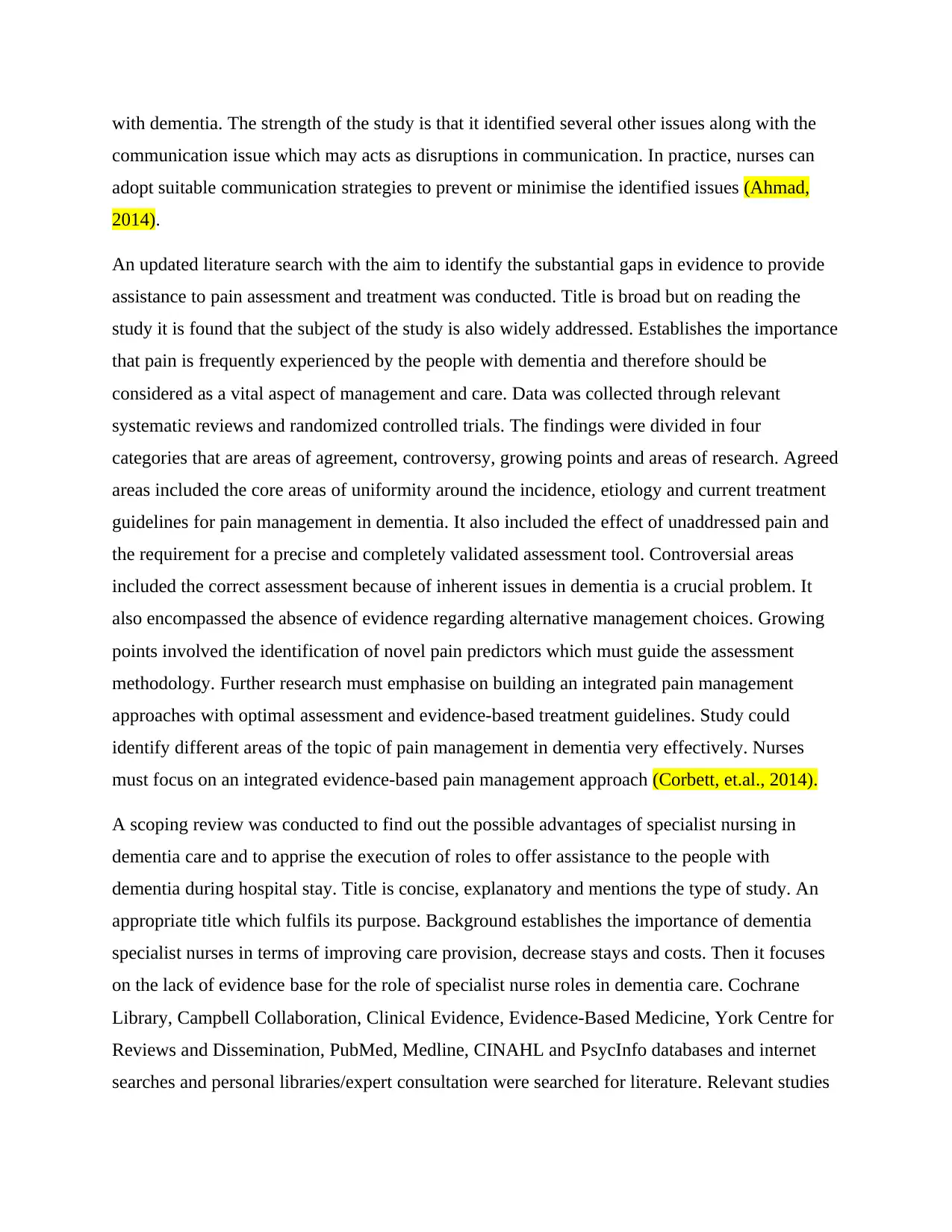
with dementia. The strength of the study is that it identified several other issues along with the
communication issue which may acts as disruptions in communication. In practice, nurses can
adopt suitable communication strategies to prevent or minimise the identified issues (Ahmad,
2014).
An updated literature search with the aim to identify the substantial gaps in evidence to provide
assistance to pain assessment and treatment was conducted. Title is broad but on reading the
study it is found that the subject of the study is also widely addressed. Establishes the importance
that pain is frequently experienced by the people with dementia and therefore should be
considered as a vital aspect of management and care. Data was collected through relevant
systematic reviews and randomized controlled trials. The findings were divided in four
categories that are areas of agreement, controversy, growing points and areas of research. Agreed
areas included the core areas of uniformity around the incidence, etiology and current treatment
guidelines for pain management in dementia. It also included the effect of unaddressed pain and
the requirement for a precise and completely validated assessment tool. Controversial areas
included the correct assessment because of inherent issues in dementia is a crucial problem. It
also encompassed the absence of evidence regarding alternative management choices. Growing
points involved the identification of novel pain predictors which must guide the assessment
methodology. Further research must emphasise on building an integrated pain management
approaches with optimal assessment and evidence-based treatment guidelines. Study could
identify different areas of the topic of pain management in dementia very effectively. Nurses
must focus on an integrated evidence-based pain management approach (Corbett, et.al., 2014).
A scoping review was conducted to find out the possible advantages of specialist nursing in
dementia care and to apprise the execution of roles to offer assistance to the people with
dementia during hospital stay. Title is concise, explanatory and mentions the type of study. An
appropriate title which fulfils its purpose. Background establishes the importance of dementia
specialist nurses in terms of improving care provision, decrease stays and costs. Then it focuses
on the lack of evidence base for the role of specialist nurse roles in dementia care. Cochrane
Library, Campbell Collaboration, Clinical Evidence, Evidence‐Based Medicine, York Centre for
Reviews and Dissemination, PubMed, Medline, CINAHL and PsycInfo databases and internet
searches and personal libraries/expert consultation were searched for literature. Relevant studies
communication issue which may acts as disruptions in communication. In practice, nurses can
adopt suitable communication strategies to prevent or minimise the identified issues (Ahmad,
2014).
An updated literature search with the aim to identify the substantial gaps in evidence to provide
assistance to pain assessment and treatment was conducted. Title is broad but on reading the
study it is found that the subject of the study is also widely addressed. Establishes the importance
that pain is frequently experienced by the people with dementia and therefore should be
considered as a vital aspect of management and care. Data was collected through relevant
systematic reviews and randomized controlled trials. The findings were divided in four
categories that are areas of agreement, controversy, growing points and areas of research. Agreed
areas included the core areas of uniformity around the incidence, etiology and current treatment
guidelines for pain management in dementia. It also included the effect of unaddressed pain and
the requirement for a precise and completely validated assessment tool. Controversial areas
included the correct assessment because of inherent issues in dementia is a crucial problem. It
also encompassed the absence of evidence regarding alternative management choices. Growing
points involved the identification of novel pain predictors which must guide the assessment
methodology. Further research must emphasise on building an integrated pain management
approaches with optimal assessment and evidence-based treatment guidelines. Study could
identify different areas of the topic of pain management in dementia very effectively. Nurses
must focus on an integrated evidence-based pain management approach (Corbett, et.al., 2014).
A scoping review was conducted to find out the possible advantages of specialist nursing in
dementia care and to apprise the execution of roles to offer assistance to the people with
dementia during hospital stay. Title is concise, explanatory and mentions the type of study. An
appropriate title which fulfils its purpose. Background establishes the importance of dementia
specialist nurses in terms of improving care provision, decrease stays and costs. Then it focuses
on the lack of evidence base for the role of specialist nurse roles in dementia care. Cochrane
Library, Campbell Collaboration, Clinical Evidence, Evidence‐Based Medicine, York Centre for
Reviews and Dissemination, PubMed, Medline, CINAHL and PsycInfo databases and internet
searches and personal libraries/expert consultation were searched for literature. Relevant studies
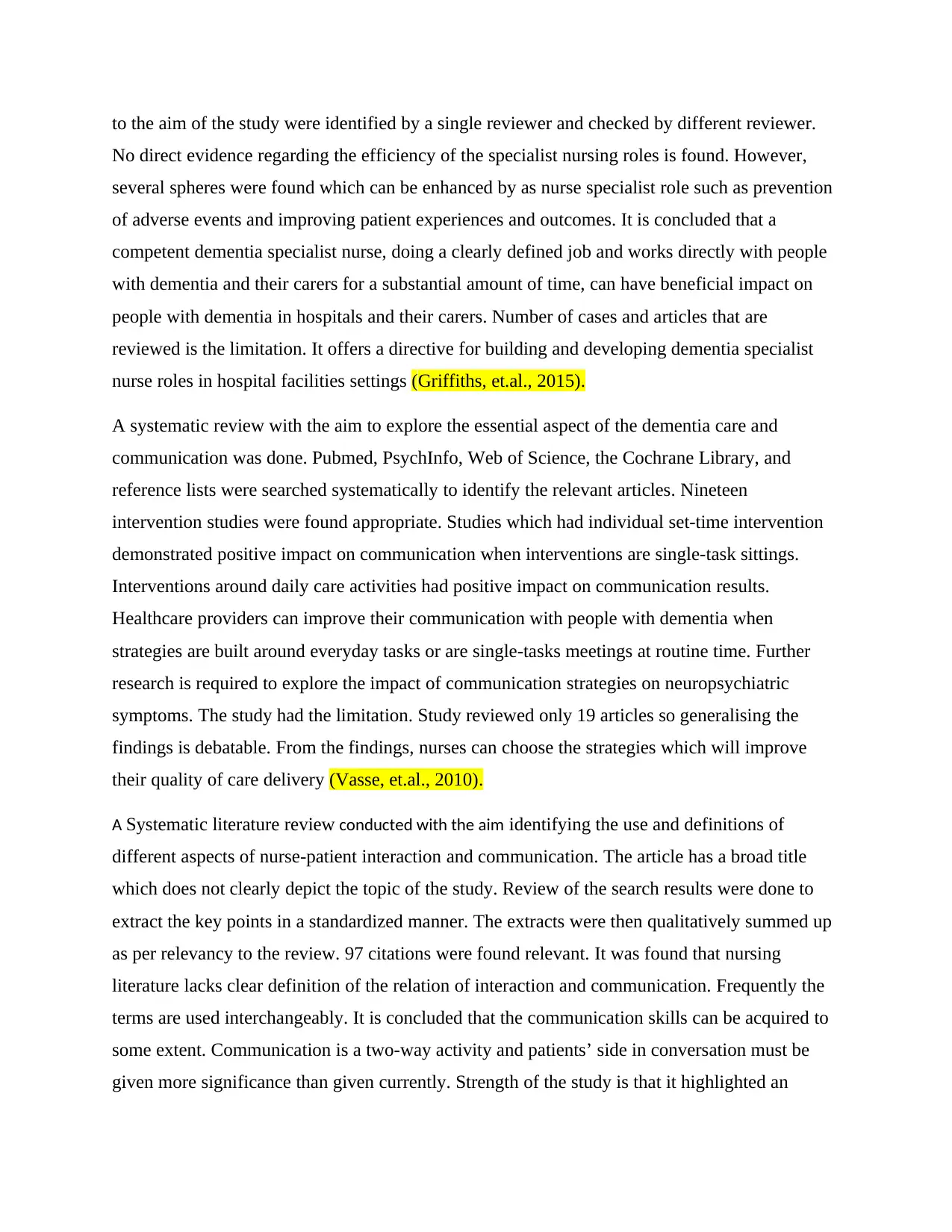
to the aim of the study were identified by a single reviewer and checked by different reviewer.
No direct evidence regarding the efficiency of the specialist nursing roles is found. However,
several spheres were found which can be enhanced by as nurse specialist role such as prevention
of adverse events and improving patient experiences and outcomes. It is concluded that a
competent dementia specialist nurse, doing a clearly defined job and works directly with people
with dementia and their carers for a substantial amount of time, can have beneficial impact on
people with dementia in hospitals and their carers. Number of cases and articles that are
reviewed is the limitation. It offers a directive for building and developing dementia specialist
nurse roles in hospital facilities settings (Griffiths, et.al., 2015).
A systematic review with the aim to explore the essential aspect of the dementia care and
communication was done. Pubmed, PsychInfo, Web of Science, the Cochrane Library, and
reference lists were searched systematically to identify the relevant articles. Nineteen
intervention studies were found appropriate. Studies which had individual set-time intervention
demonstrated positive impact on communication when interventions are single-task sittings.
Interventions around daily care activities had positive impact on communication results.
Healthcare providers can improve their communication with people with dementia when
strategies are built around everyday tasks or are single-tasks meetings at routine time. Further
research is required to explore the impact of communication strategies on neuropsychiatric
symptoms. The study had the limitation. Study reviewed only 19 articles so generalising the
findings is debatable. From the findings, nurses can choose the strategies which will improve
their quality of care delivery (Vasse, et.al., 2010).
A Systematic literature review conducted with the aim identifying the use and definitions of
different aspects of nurse-patient interaction and communication. The article has a broad title
which does not clearly depict the topic of the study. Review of the search results were done to
extract the key points in a standardized manner. The extracts were then qualitatively summed up
as per relevancy to the review. 97 citations were found relevant. It was found that nursing
literature lacks clear definition of the relation of interaction and communication. Frequently the
terms are used interchangeably. It is concluded that the communication skills can be acquired to
some extent. Communication is a two-way activity and patients’ side in conversation must be
given more significance than given currently. Strength of the study is that it highlighted an
No direct evidence regarding the efficiency of the specialist nursing roles is found. However,
several spheres were found which can be enhanced by as nurse specialist role such as prevention
of adverse events and improving patient experiences and outcomes. It is concluded that a
competent dementia specialist nurse, doing a clearly defined job and works directly with people
with dementia and their carers for a substantial amount of time, can have beneficial impact on
people with dementia in hospitals and their carers. Number of cases and articles that are
reviewed is the limitation. It offers a directive for building and developing dementia specialist
nurse roles in hospital facilities settings (Griffiths, et.al., 2015).
A systematic review with the aim to explore the essential aspect of the dementia care and
communication was done. Pubmed, PsychInfo, Web of Science, the Cochrane Library, and
reference lists were searched systematically to identify the relevant articles. Nineteen
intervention studies were found appropriate. Studies which had individual set-time intervention
demonstrated positive impact on communication when interventions are single-task sittings.
Interventions around daily care activities had positive impact on communication results.
Healthcare providers can improve their communication with people with dementia when
strategies are built around everyday tasks or are single-tasks meetings at routine time. Further
research is required to explore the impact of communication strategies on neuropsychiatric
symptoms. The study had the limitation. Study reviewed only 19 articles so generalising the
findings is debatable. From the findings, nurses can choose the strategies which will improve
their quality of care delivery (Vasse, et.al., 2010).
A Systematic literature review conducted with the aim identifying the use and definitions of
different aspects of nurse-patient interaction and communication. The article has a broad title
which does not clearly depict the topic of the study. Review of the search results were done to
extract the key points in a standardized manner. The extracts were then qualitatively summed up
as per relevancy to the review. 97 citations were found relevant. It was found that nursing
literature lacks clear definition of the relation of interaction and communication. Frequently the
terms are used interchangeably. It is concluded that the communication skills can be acquired to
some extent. Communication is a two-way activity and patients’ side in conversation must be
given more significance than given currently. Strength of the study is that it highlighted an
⊘ This is a preview!⊘
Do you want full access?
Subscribe today to unlock all pages.

Trusted by 1+ million students worldwide
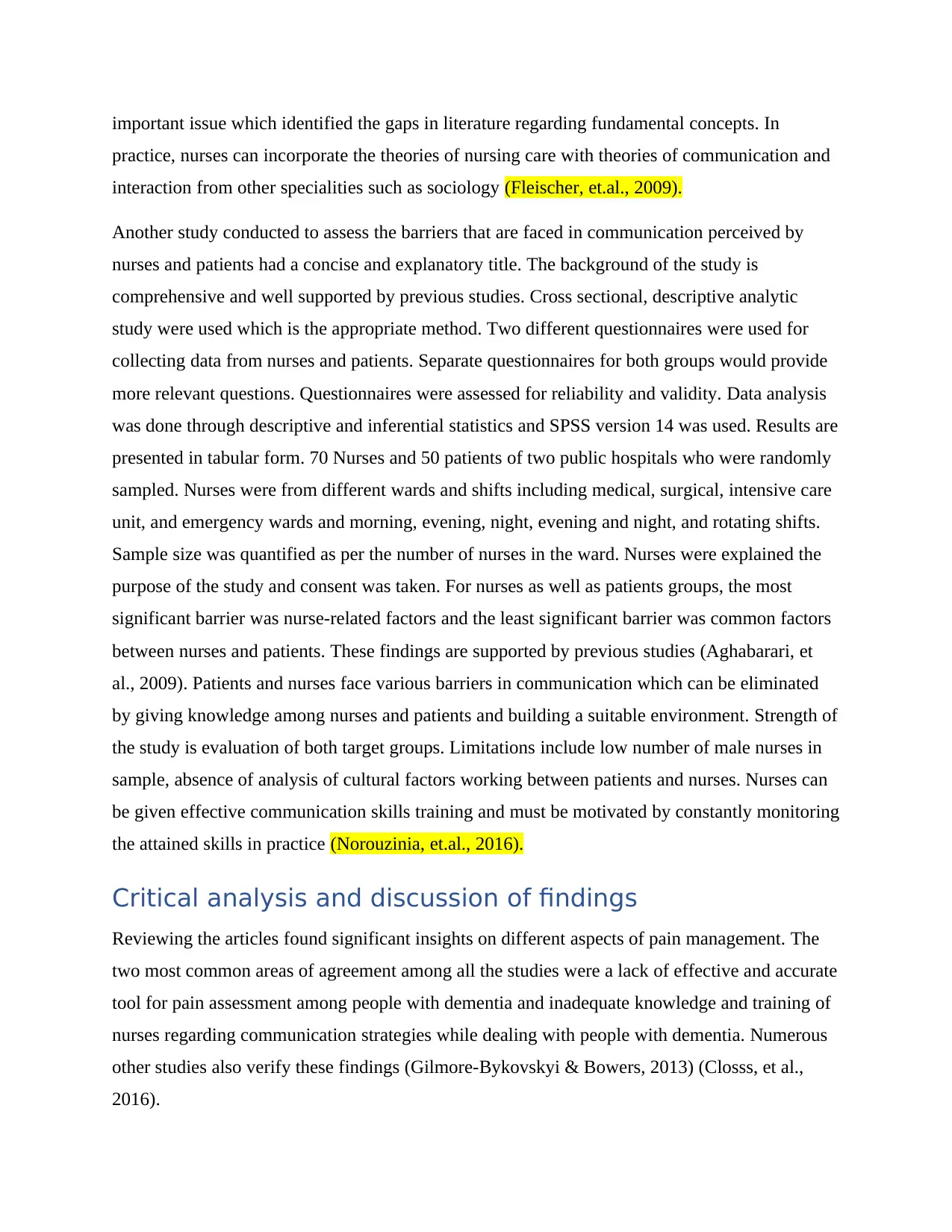
important issue which identified the gaps in literature regarding fundamental concepts. In
practice, nurses can incorporate the theories of nursing care with theories of communication and
interaction from other specialities such as sociology (Fleischer, et.al., 2009).
Another study conducted to assess the barriers that are faced in communication perceived by
nurses and patients had a concise and explanatory title. The background of the study is
comprehensive and well supported by previous studies. Cross sectional, descriptive analytic
study were used which is the appropriate method. Two different questionnaires were used for
collecting data from nurses and patients. Separate questionnaires for both groups would provide
more relevant questions. Questionnaires were assessed for reliability and validity. Data analysis
was done through descriptive and inferential statistics and SPSS version 14 was used. Results are
presented in tabular form. 70 Nurses and 50 patients of two public hospitals who were randomly
sampled. Nurses were from different wards and shifts including medical, surgical, intensive care
unit, and emergency wards and morning, evening, night, evening and night, and rotating shifts.
Sample size was quantified as per the number of nurses in the ward. Nurses were explained the
purpose of the study and consent was taken. For nurses as well as patients groups, the most
significant barrier was nurse-related factors and the least significant barrier was common factors
between nurses and patients. These findings are supported by previous studies (Aghabarari, et
al., 2009). Patients and nurses face various barriers in communication which can be eliminated
by giving knowledge among nurses and patients and building a suitable environment. Strength of
the study is evaluation of both target groups. Limitations include low number of male nurses in
sample, absence of analysis of cultural factors working between patients and nurses. Nurses can
be given effective communication skills training and must be motivated by constantly monitoring
the attained skills in practice (Norouzinia, et.al., 2016).
Critical analysis and discussion of findings
Reviewing the articles found significant insights on different aspects of pain management. The
two most common areas of agreement among all the studies were a lack of effective and accurate
tool for pain assessment among people with dementia and inadequate knowledge and training of
nurses regarding communication strategies while dealing with people with dementia. Numerous
other studies also verify these findings (Gilmore-Bykovskyi & Bowers, 2013) (Closss, et al.,
2016).
practice, nurses can incorporate the theories of nursing care with theories of communication and
interaction from other specialities such as sociology (Fleischer, et.al., 2009).
Another study conducted to assess the barriers that are faced in communication perceived by
nurses and patients had a concise and explanatory title. The background of the study is
comprehensive and well supported by previous studies. Cross sectional, descriptive analytic
study were used which is the appropriate method. Two different questionnaires were used for
collecting data from nurses and patients. Separate questionnaires for both groups would provide
more relevant questions. Questionnaires were assessed for reliability and validity. Data analysis
was done through descriptive and inferential statistics and SPSS version 14 was used. Results are
presented in tabular form. 70 Nurses and 50 patients of two public hospitals who were randomly
sampled. Nurses were from different wards and shifts including medical, surgical, intensive care
unit, and emergency wards and morning, evening, night, evening and night, and rotating shifts.
Sample size was quantified as per the number of nurses in the ward. Nurses were explained the
purpose of the study and consent was taken. For nurses as well as patients groups, the most
significant barrier was nurse-related factors and the least significant barrier was common factors
between nurses and patients. These findings are supported by previous studies (Aghabarari, et
al., 2009). Patients and nurses face various barriers in communication which can be eliminated
by giving knowledge among nurses and patients and building a suitable environment. Strength of
the study is evaluation of both target groups. Limitations include low number of male nurses in
sample, absence of analysis of cultural factors working between patients and nurses. Nurses can
be given effective communication skills training and must be motivated by constantly monitoring
the attained skills in practice (Norouzinia, et.al., 2016).
Critical analysis and discussion of findings
Reviewing the articles found significant insights on different aspects of pain management. The
two most common areas of agreement among all the studies were a lack of effective and accurate
tool for pain assessment among people with dementia and inadequate knowledge and training of
nurses regarding communication strategies while dealing with people with dementia. Numerous
other studies also verify these findings (Gilmore-Bykovskyi & Bowers, 2013) (Closss, et al.,
2016).
Paraphrase This Document
Need a fresh take? Get an instant paraphrase of this document with our AI Paraphraser
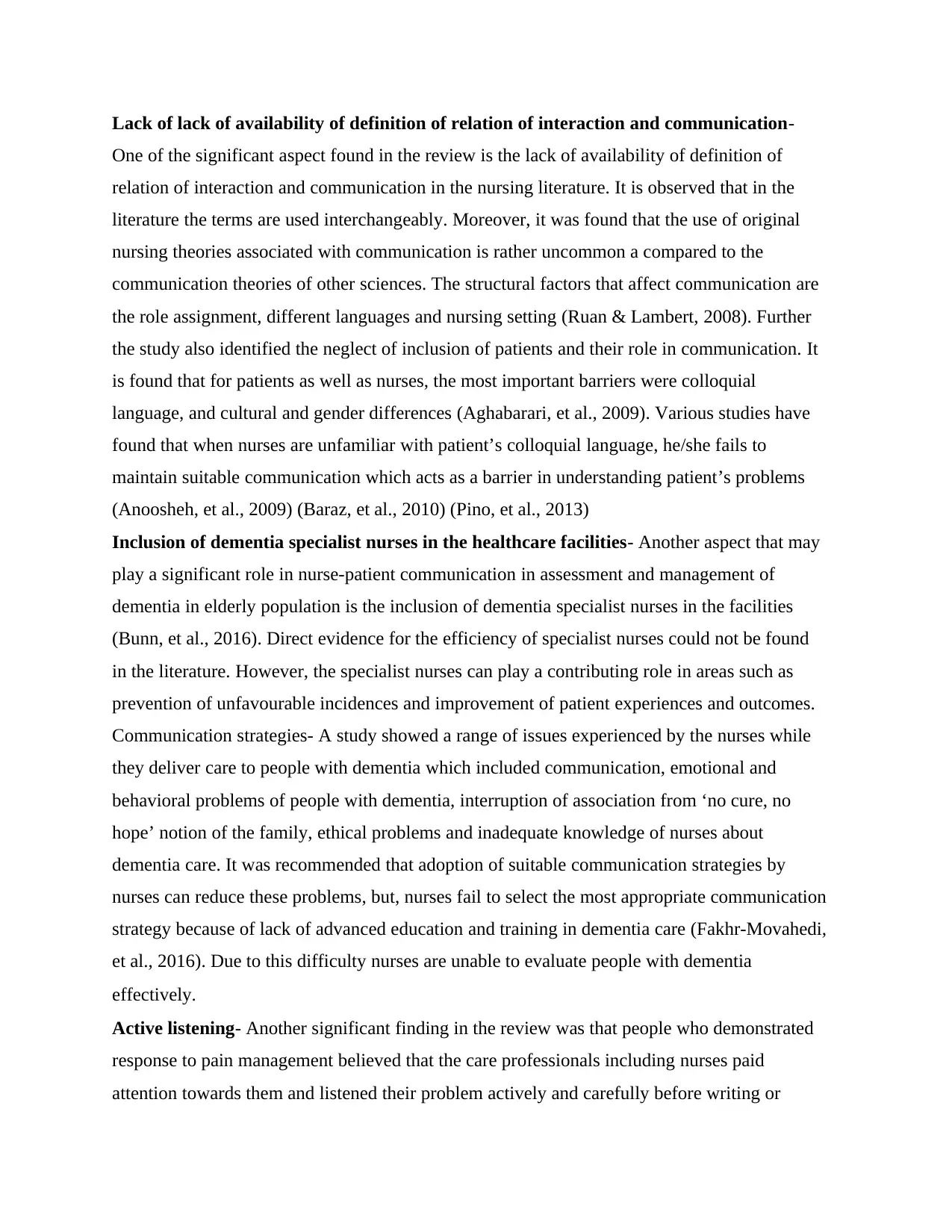
Lack of lack of availability of definition of relation of interaction and communication-
One of the significant aspect found in the review is the lack of availability of definition of
relation of interaction and communication in the nursing literature. It is observed that in the
literature the terms are used interchangeably. Moreover, it was found that the use of original
nursing theories associated with communication is rather uncommon a compared to the
communication theories of other sciences. The structural factors that affect communication are
the role assignment, different languages and nursing setting (Ruan & Lambert, 2008). Further
the study also identified the neglect of inclusion of patients and their role in communication. It
is found that for patients as well as nurses, the most important barriers were colloquial
language, and cultural and gender differences (Aghabarari, et al., 2009). Various studies have
found that when nurses are unfamiliar with patient’s colloquial language, he/she fails to
maintain suitable communication which acts as a barrier in understanding patient’s problems
(Anoosheh, et al., 2009) (Baraz, et al., 2010) (Pino, et al., 2013)
Inclusion of dementia specialist nurses in the healthcare facilities- Another aspect that may
play a significant role in nurse-patient communication in assessment and management of
dementia in elderly population is the inclusion of dementia specialist nurses in the facilities
(Bunn, et al., 2016). Direct evidence for the efficiency of specialist nurses could not be found
in the literature. However, the specialist nurses can play a contributing role in areas such as
prevention of unfavourable incidences and improvement of patient experiences and outcomes.
Communication strategies- A study showed a range of issues experienced by the nurses while
they deliver care to people with dementia which included communication, emotional and
behavioral problems of people with dementia, interruption of association from ‘no cure, no
hope’ notion of the family, ethical problems and inadequate knowledge of nurses about
dementia care. It was recommended that adoption of suitable communication strategies by
nurses can reduce these problems, but, nurses fail to select the most appropriate communication
strategy because of lack of advanced education and training in dementia care (Fakhr-Movahedi,
et al., 2016). Due to this difficulty nurses are unable to evaluate people with dementia
effectively.
Active listening- Another significant finding in the review was that people who demonstrated
response to pain management believed that the care professionals including nurses paid
attention towards them and listened their problem actively and carefully before writing or
One of the significant aspect found in the review is the lack of availability of definition of
relation of interaction and communication in the nursing literature. It is observed that in the
literature the terms are used interchangeably. Moreover, it was found that the use of original
nursing theories associated with communication is rather uncommon a compared to the
communication theories of other sciences. The structural factors that affect communication are
the role assignment, different languages and nursing setting (Ruan & Lambert, 2008). Further
the study also identified the neglect of inclusion of patients and their role in communication. It
is found that for patients as well as nurses, the most important barriers were colloquial
language, and cultural and gender differences (Aghabarari, et al., 2009). Various studies have
found that when nurses are unfamiliar with patient’s colloquial language, he/she fails to
maintain suitable communication which acts as a barrier in understanding patient’s problems
(Anoosheh, et al., 2009) (Baraz, et al., 2010) (Pino, et al., 2013)
Inclusion of dementia specialist nurses in the healthcare facilities- Another aspect that may
play a significant role in nurse-patient communication in assessment and management of
dementia in elderly population is the inclusion of dementia specialist nurses in the facilities
(Bunn, et al., 2016). Direct evidence for the efficiency of specialist nurses could not be found
in the literature. However, the specialist nurses can play a contributing role in areas such as
prevention of unfavourable incidences and improvement of patient experiences and outcomes.
Communication strategies- A study showed a range of issues experienced by the nurses while
they deliver care to people with dementia which included communication, emotional and
behavioral problems of people with dementia, interruption of association from ‘no cure, no
hope’ notion of the family, ethical problems and inadequate knowledge of nurses about
dementia care. It was recommended that adoption of suitable communication strategies by
nurses can reduce these problems, but, nurses fail to select the most appropriate communication
strategy because of lack of advanced education and training in dementia care (Fakhr-Movahedi,
et al., 2016). Due to this difficulty nurses are unable to evaluate people with dementia
effectively.
Active listening- Another significant finding in the review was that people who demonstrated
response to pain management believed that the care professionals including nurses paid
attention towards them and listened their problem actively and carefully before writing or
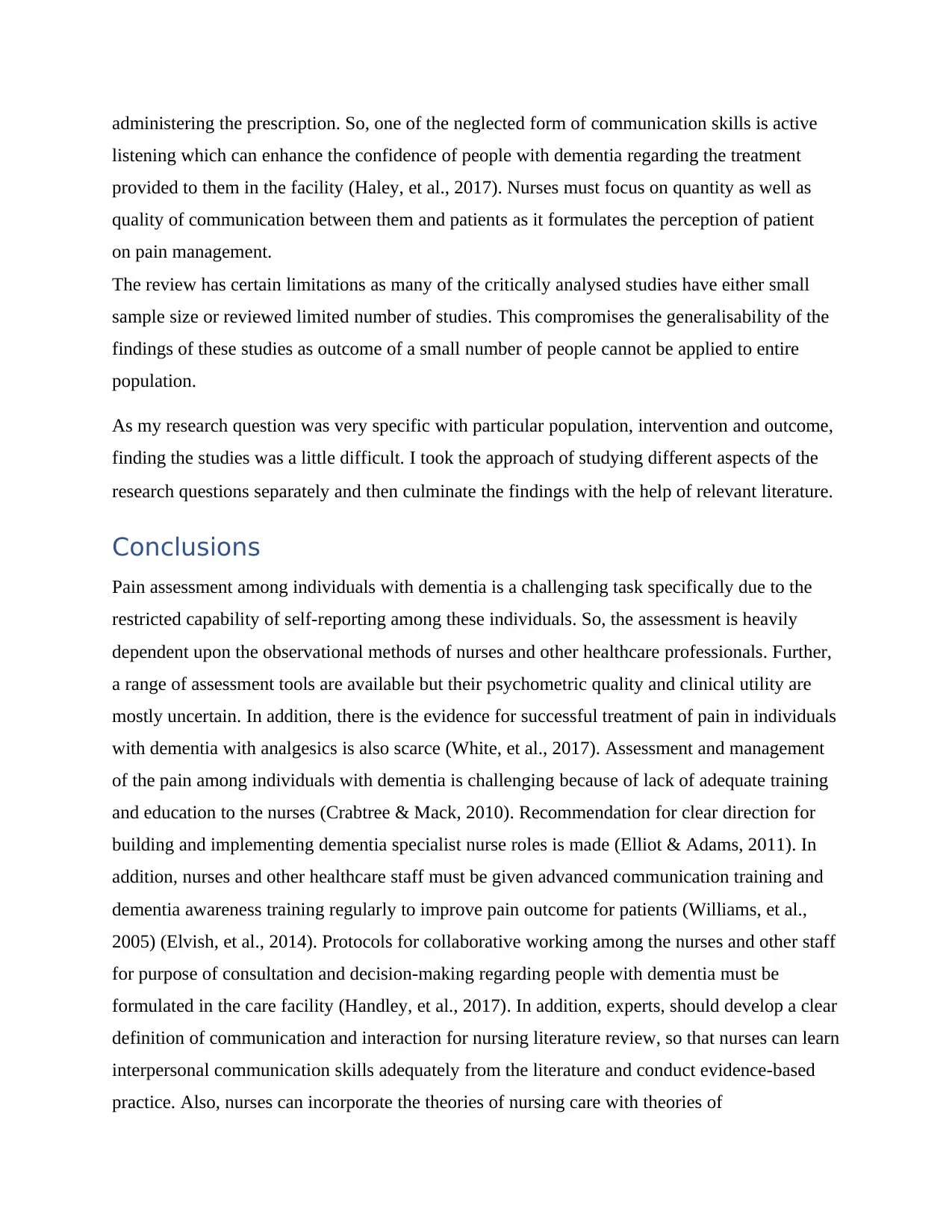
administering the prescription. So, one of the neglected form of communication skills is active
listening which can enhance the confidence of people with dementia regarding the treatment
provided to them in the facility (Haley, et al., 2017). Nurses must focus on quantity as well as
quality of communication between them and patients as it formulates the perception of patient
on pain management.
The review has certain limitations as many of the critically analysed studies have either small
sample size or reviewed limited number of studies. This compromises the generalisability of the
findings of these studies as outcome of a small number of people cannot be applied to entire
population.
As my research question was very specific with particular population, intervention and outcome,
finding the studies was a little difficult. I took the approach of studying different aspects of the
research questions separately and then culminate the findings with the help of relevant literature.
Conclusions
Pain assessment among individuals with dementia is a challenging task specifically due to the
restricted capability of self-reporting among these individuals. So, the assessment is heavily
dependent upon the observational methods of nurses and other healthcare professionals. Further,
a range of assessment tools are available but their psychometric quality and clinical utility are
mostly uncertain. In addition, there is the evidence for successful treatment of pain in individuals
with dementia with analgesics is also scarce (White, et al., 2017). Assessment and management
of the pain among individuals with dementia is challenging because of lack of adequate training
and education to the nurses (Crabtree & Mack, 2010). Recommendation for clear direction for
building and implementing dementia specialist nurse roles is made (Elliot & Adams, 2011). In
addition, nurses and other healthcare staff must be given advanced communication training and
dementia awareness training regularly to improve pain outcome for patients (Williams, et al.,
2005) (Elvish, et al., 2014). Protocols for collaborative working among the nurses and other staff
for purpose of consultation and decision-making regarding people with dementia must be
formulated in the care facility (Handley, et al., 2017). In addition, experts, should develop a clear
definition of communication and interaction for nursing literature review, so that nurses can learn
interpersonal communication skills adequately from the literature and conduct evidence-based
practice. Also, nurses can incorporate the theories of nursing care with theories of
listening which can enhance the confidence of people with dementia regarding the treatment
provided to them in the facility (Haley, et al., 2017). Nurses must focus on quantity as well as
quality of communication between them and patients as it formulates the perception of patient
on pain management.
The review has certain limitations as many of the critically analysed studies have either small
sample size or reviewed limited number of studies. This compromises the generalisability of the
findings of these studies as outcome of a small number of people cannot be applied to entire
population.
As my research question was very specific with particular population, intervention and outcome,
finding the studies was a little difficult. I took the approach of studying different aspects of the
research questions separately and then culminate the findings with the help of relevant literature.
Conclusions
Pain assessment among individuals with dementia is a challenging task specifically due to the
restricted capability of self-reporting among these individuals. So, the assessment is heavily
dependent upon the observational methods of nurses and other healthcare professionals. Further,
a range of assessment tools are available but their psychometric quality and clinical utility are
mostly uncertain. In addition, there is the evidence for successful treatment of pain in individuals
with dementia with analgesics is also scarce (White, et al., 2017). Assessment and management
of the pain among individuals with dementia is challenging because of lack of adequate training
and education to the nurses (Crabtree & Mack, 2010). Recommendation for clear direction for
building and implementing dementia specialist nurse roles is made (Elliot & Adams, 2011). In
addition, nurses and other healthcare staff must be given advanced communication training and
dementia awareness training regularly to improve pain outcome for patients (Williams, et al.,
2005) (Elvish, et al., 2014). Protocols for collaborative working among the nurses and other staff
for purpose of consultation and decision-making regarding people with dementia must be
formulated in the care facility (Handley, et al., 2017). In addition, experts, should develop a clear
definition of communication and interaction for nursing literature review, so that nurses can learn
interpersonal communication skills adequately from the literature and conduct evidence-based
practice. Also, nurses can incorporate the theories of nursing care with theories of
⊘ This is a preview!⊘
Do you want full access?
Subscribe today to unlock all pages.

Trusted by 1+ million students worldwide
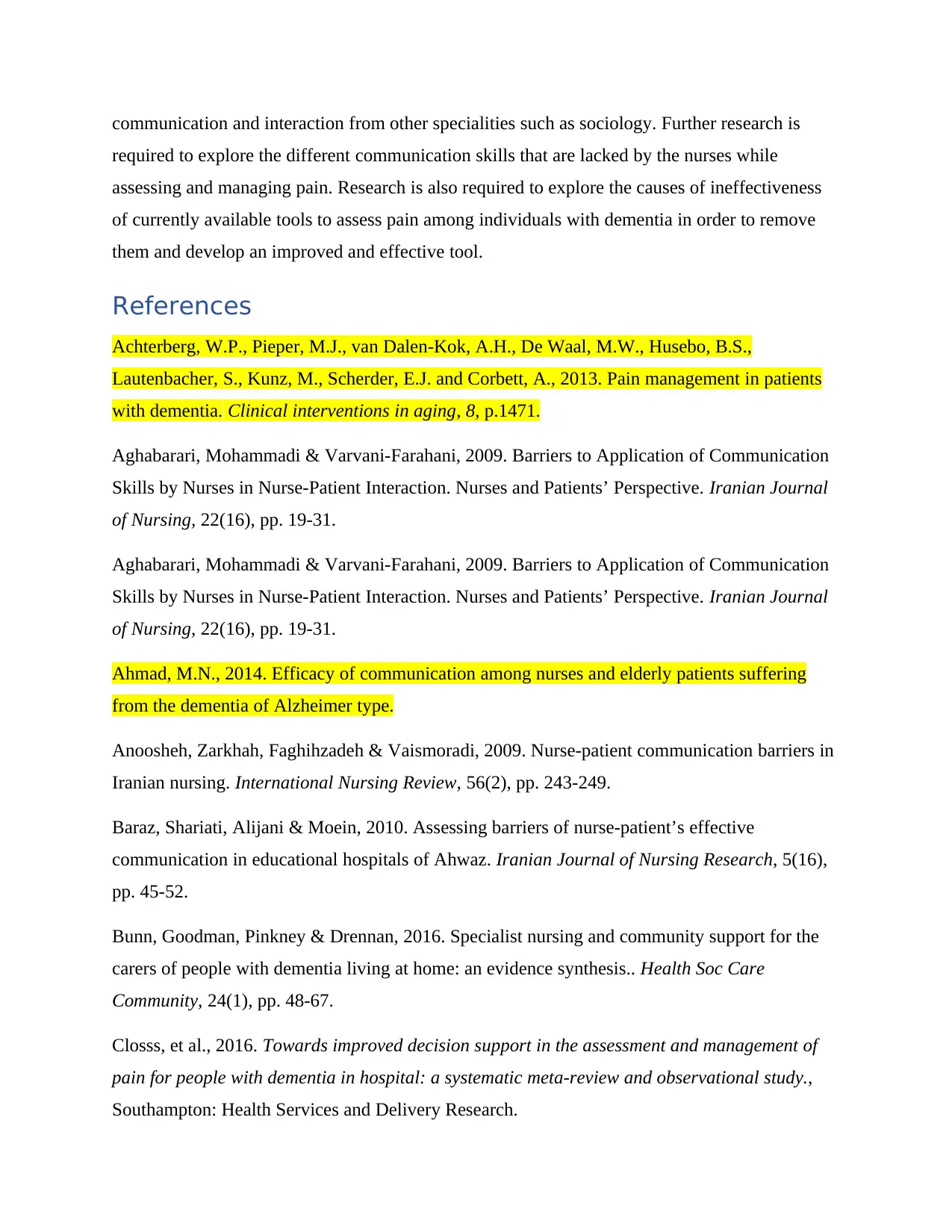
communication and interaction from other specialities such as sociology. Further research is
required to explore the different communication skills that are lacked by the nurses while
assessing and managing pain. Research is also required to explore the causes of ineffectiveness
of currently available tools to assess pain among individuals with dementia in order to remove
them and develop an improved and effective tool.
References
Achterberg, W.P., Pieper, M.J., van Dalen-Kok, A.H., De Waal, M.W., Husebo, B.S.,
Lautenbacher, S., Kunz, M., Scherder, E.J. and Corbett, A., 2013. Pain management in patients
with dementia. Clinical interventions in aging, 8, p.1471.
Aghabarari, Mohammadi & Varvani-Farahani, 2009. Barriers to Application of Communication
Skills by Nurses in Nurse-Patient Interaction. Nurses and Patients’ Perspective. Iranian Journal
of Nursing, 22(16), pp. 19-31.
Aghabarari, Mohammadi & Varvani-Farahani, 2009. Barriers to Application of Communication
Skills by Nurses in Nurse-Patient Interaction. Nurses and Patients’ Perspective. Iranian Journal
of Nursing, 22(16), pp. 19-31.
Ahmad, M.N., 2014. Efficacy of communication among nurses and elderly patients suffering
from the dementia of Alzheimer type.
Anoosheh, Zarkhah, Faghihzadeh & Vaismoradi, 2009. Nurse-patient communication barriers in
Iranian nursing. International Nursing Review, 56(2), pp. 243-249.
Baraz, Shariati, Alijani & Moein, 2010. Assessing barriers of nurse-patient’s effective
communication in educational hospitals of Ahwaz. Iranian Journal of Nursing Research, 5(16),
pp. 45-52.
Bunn, Goodman, Pinkney & Drennan, 2016. Specialist nursing and community support for the
carers of people with dementia living at home: an evidence synthesis.. Health Soc Care
Community, 24(1), pp. 48-67.
Closss, et al., 2016. Towards improved decision support in the assessment and management of
pain for people with dementia in hospital: a systematic meta-review and observational study.,
Southampton: Health Services and Delivery Research.
required to explore the different communication skills that are lacked by the nurses while
assessing and managing pain. Research is also required to explore the causes of ineffectiveness
of currently available tools to assess pain among individuals with dementia in order to remove
them and develop an improved and effective tool.
References
Achterberg, W.P., Pieper, M.J., van Dalen-Kok, A.H., De Waal, M.W., Husebo, B.S.,
Lautenbacher, S., Kunz, M., Scherder, E.J. and Corbett, A., 2013. Pain management in patients
with dementia. Clinical interventions in aging, 8, p.1471.
Aghabarari, Mohammadi & Varvani-Farahani, 2009. Barriers to Application of Communication
Skills by Nurses in Nurse-Patient Interaction. Nurses and Patients’ Perspective. Iranian Journal
of Nursing, 22(16), pp. 19-31.
Aghabarari, Mohammadi & Varvani-Farahani, 2009. Barriers to Application of Communication
Skills by Nurses in Nurse-Patient Interaction. Nurses and Patients’ Perspective. Iranian Journal
of Nursing, 22(16), pp. 19-31.
Ahmad, M.N., 2014. Efficacy of communication among nurses and elderly patients suffering
from the dementia of Alzheimer type.
Anoosheh, Zarkhah, Faghihzadeh & Vaismoradi, 2009. Nurse-patient communication barriers in
Iranian nursing. International Nursing Review, 56(2), pp. 243-249.
Baraz, Shariati, Alijani & Moein, 2010. Assessing barriers of nurse-patient’s effective
communication in educational hospitals of Ahwaz. Iranian Journal of Nursing Research, 5(16),
pp. 45-52.
Bunn, Goodman, Pinkney & Drennan, 2016. Specialist nursing and community support for the
carers of people with dementia living at home: an evidence synthesis.. Health Soc Care
Community, 24(1), pp. 48-67.
Closss, et al., 2016. Towards improved decision support in the assessment and management of
pain for people with dementia in hospital: a systematic meta-review and observational study.,
Southampton: Health Services and Delivery Research.
Paraphrase This Document
Need a fresh take? Get an instant paraphrase of this document with our AI Paraphraser
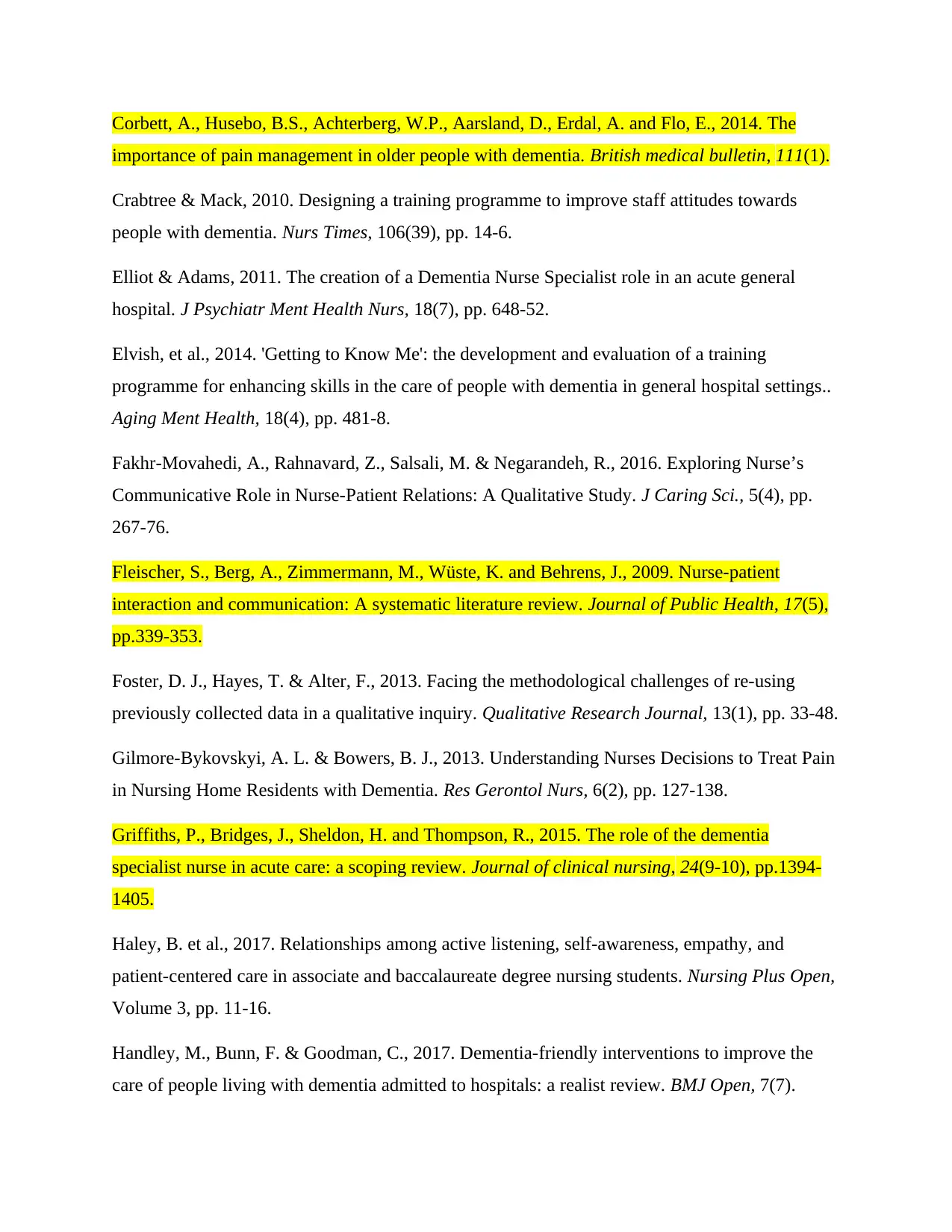
Corbett, A., Husebo, B.S., Achterberg, W.P., Aarsland, D., Erdal, A. and Flo, E., 2014. The
importance of pain management in older people with dementia. British medical bulletin, 111(1).
Crabtree & Mack, 2010. Designing a training programme to improve staff attitudes towards
people with dementia. Nurs Times, 106(39), pp. 14-6.
Elliot & Adams, 2011. The creation of a Dementia Nurse Specialist role in an acute general
hospital. J Psychiatr Ment Health Nurs, 18(7), pp. 648-52.
Elvish, et al., 2014. 'Getting to Know Me': the development and evaluation of a training
programme for enhancing skills in the care of people with dementia in general hospital settings..
Aging Ment Health, 18(4), pp. 481-8.
Fakhr-Movahedi, A., Rahnavard, Z., Salsali, M. & Negarandeh, R., 2016. Exploring Nurse’s
Communicative Role in Nurse-Patient Relations: A Qualitative Study. J Caring Sci., 5(4), pp.
267-76.
Fleischer, S., Berg, A., Zimmermann, M., Wüste, K. and Behrens, J., 2009. Nurse-patient
interaction and communication: A systematic literature review. Journal of Public Health, 17(5),
pp.339-353.
Foster, D. J., Hayes, T. & Alter, F., 2013. Facing the methodological challenges of re‐using
previously collected data in a qualitative inquiry. Qualitative Research Journal, 13(1), pp. 33-48.
Gilmore-Bykovskyi, A. L. & Bowers, B. J., 2013. Understanding Nurses Decisions to Treat Pain
in Nursing Home Residents with Dementia. Res Gerontol Nurs, 6(2), pp. 127-138.
Griffiths, P., Bridges, J., Sheldon, H. and Thompson, R., 2015. The role of the dementia
specialist nurse in acute care: a scoping review. Journal of clinical nursing, 24(9-10), pp.1394-
1405.
Haley, B. et al., 2017. Relationships among active listening, self-awareness, empathy, and
patient-centered care in associate and baccalaureate degree nursing students. Nursing Plus Open,
Volume 3, pp. 11-16.
Handley, M., Bunn, F. & Goodman, C., 2017. Dementia-friendly interventions to improve the
care of people living with dementia admitted to hospitals: a realist review. BMJ Open, 7(7).
importance of pain management in older people with dementia. British medical bulletin, 111(1).
Crabtree & Mack, 2010. Designing a training programme to improve staff attitudes towards
people with dementia. Nurs Times, 106(39), pp. 14-6.
Elliot & Adams, 2011. The creation of a Dementia Nurse Specialist role in an acute general
hospital. J Psychiatr Ment Health Nurs, 18(7), pp. 648-52.
Elvish, et al., 2014. 'Getting to Know Me': the development and evaluation of a training
programme for enhancing skills in the care of people with dementia in general hospital settings..
Aging Ment Health, 18(4), pp. 481-8.
Fakhr-Movahedi, A., Rahnavard, Z., Salsali, M. & Negarandeh, R., 2016. Exploring Nurse’s
Communicative Role in Nurse-Patient Relations: A Qualitative Study. J Caring Sci., 5(4), pp.
267-76.
Fleischer, S., Berg, A., Zimmermann, M., Wüste, K. and Behrens, J., 2009. Nurse-patient
interaction and communication: A systematic literature review. Journal of Public Health, 17(5),
pp.339-353.
Foster, D. J., Hayes, T. & Alter, F., 2013. Facing the methodological challenges of re‐using
previously collected data in a qualitative inquiry. Qualitative Research Journal, 13(1), pp. 33-48.
Gilmore-Bykovskyi, A. L. & Bowers, B. J., 2013. Understanding Nurses Decisions to Treat Pain
in Nursing Home Residents with Dementia. Res Gerontol Nurs, 6(2), pp. 127-138.
Griffiths, P., Bridges, J., Sheldon, H. and Thompson, R., 2015. The role of the dementia
specialist nurse in acute care: a scoping review. Journal of clinical nursing, 24(9-10), pp.1394-
1405.
Haley, B. et al., 2017. Relationships among active listening, self-awareness, empathy, and
patient-centered care in associate and baccalaureate degree nursing students. Nursing Plus Open,
Volume 3, pp. 11-16.
Handley, M., Bunn, F. & Goodman, C., 2017. Dementia-friendly interventions to improve the
care of people living with dementia admitted to hospitals: a realist review. BMJ Open, 7(7).
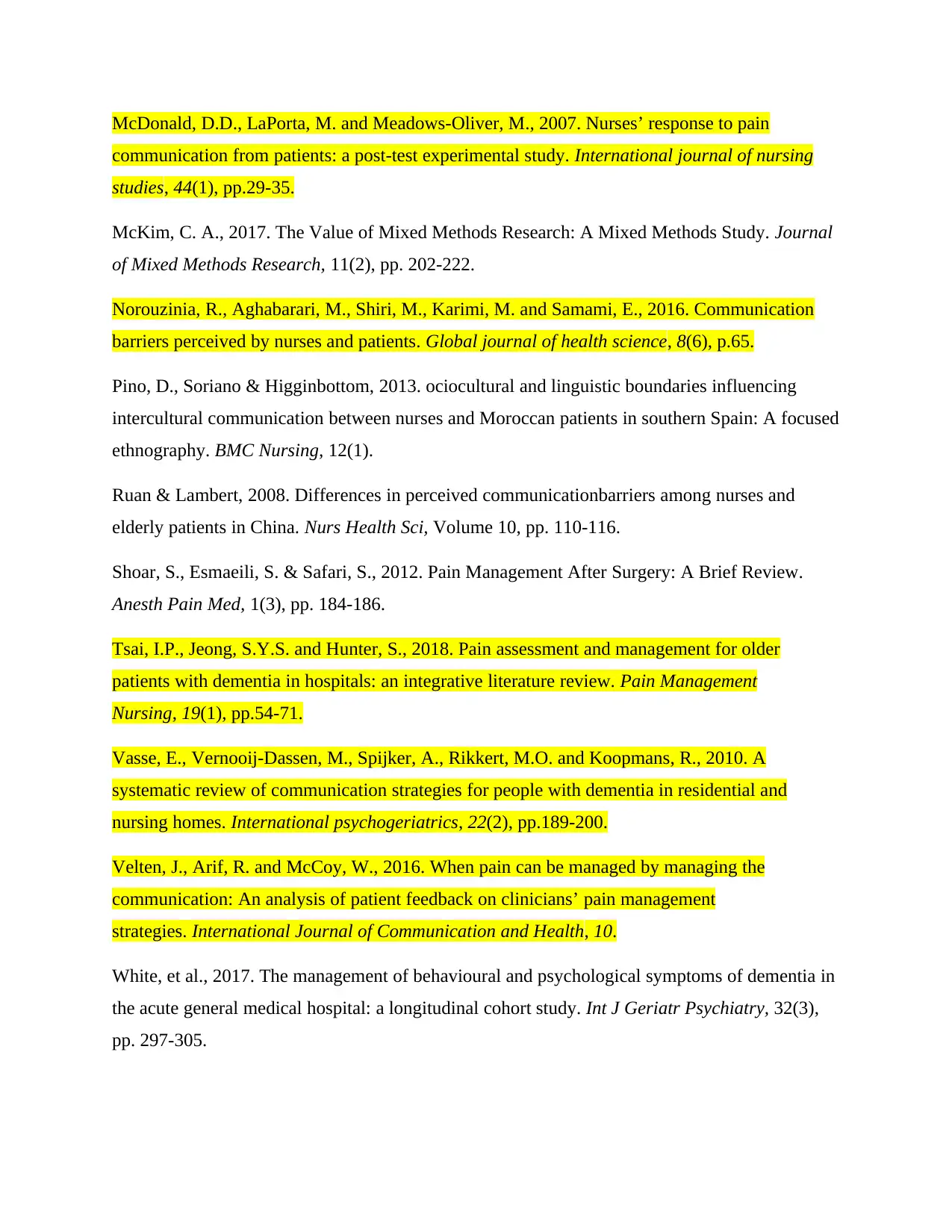
McDonald, D.D., LaPorta, M. and Meadows-Oliver, M., 2007. Nurses’ response to pain
communication from patients: a post-test experimental study. International journal of nursing
studies, 44(1), pp.29-35.
McKim, C. A., 2017. The Value of Mixed Methods Research: A Mixed Methods Study. Journal
of Mixed Methods Research, 11(2), pp. 202-222.
Norouzinia, R., Aghabarari, M., Shiri, M., Karimi, M. and Samami, E., 2016. Communication
barriers perceived by nurses and patients. Global journal of health science, 8(6), p.65.
Pino, D., Soriano & Higginbottom, 2013. ociocultural and linguistic boundaries influencing
intercultural communication between nurses and Moroccan patients in southern Spain: A focused
ethnography. BMC Nursing, 12(1).
Ruan & Lambert, 2008. Differences in perceived communicationbarriers among nurses and
elderly patients in China. Nurs Health Sci, Volume 10, pp. 110-116.
Shoar, S., Esmaeili, S. & Safari, S., 2012. Pain Management After Surgery: A Brief Review.
Anesth Pain Med, 1(3), pp. 184-186.
Tsai, I.P., Jeong, S.Y.S. and Hunter, S., 2018. Pain assessment and management for older
patients with dementia in hospitals: an integrative literature review. Pain Management
Nursing, 19(1), pp.54-71.
Vasse, E., Vernooij-Dassen, M., Spijker, A., Rikkert, M.O. and Koopmans, R., 2010. A
systematic review of communication strategies for people with dementia in residential and
nursing homes. International psychogeriatrics, 22(2), pp.189-200.
Velten, J., Arif, R. and McCoy, W., 2016. When pain can be managed by managing the
communication: An analysis of patient feedback on clinicians’ pain management
strategies. International Journal of Communication and Health, 10.
White, et al., 2017. The management of behavioural and psychological symptoms of dementia in
the acute general medical hospital: a longitudinal cohort study. Int J Geriatr Psychiatry, 32(3),
pp. 297-305.
communication from patients: a post-test experimental study. International journal of nursing
studies, 44(1), pp.29-35.
McKim, C. A., 2017. The Value of Mixed Methods Research: A Mixed Methods Study. Journal
of Mixed Methods Research, 11(2), pp. 202-222.
Norouzinia, R., Aghabarari, M., Shiri, M., Karimi, M. and Samami, E., 2016. Communication
barriers perceived by nurses and patients. Global journal of health science, 8(6), p.65.
Pino, D., Soriano & Higginbottom, 2013. ociocultural and linguistic boundaries influencing
intercultural communication between nurses and Moroccan patients in southern Spain: A focused
ethnography. BMC Nursing, 12(1).
Ruan & Lambert, 2008. Differences in perceived communicationbarriers among nurses and
elderly patients in China. Nurs Health Sci, Volume 10, pp. 110-116.
Shoar, S., Esmaeili, S. & Safari, S., 2012. Pain Management After Surgery: A Brief Review.
Anesth Pain Med, 1(3), pp. 184-186.
Tsai, I.P., Jeong, S.Y.S. and Hunter, S., 2018. Pain assessment and management for older
patients with dementia in hospitals: an integrative literature review. Pain Management
Nursing, 19(1), pp.54-71.
Vasse, E., Vernooij-Dassen, M., Spijker, A., Rikkert, M.O. and Koopmans, R., 2010. A
systematic review of communication strategies for people with dementia in residential and
nursing homes. International psychogeriatrics, 22(2), pp.189-200.
Velten, J., Arif, R. and McCoy, W., 2016. When pain can be managed by managing the
communication: An analysis of patient feedback on clinicians’ pain management
strategies. International Journal of Communication and Health, 10.
White, et al., 2017. The management of behavioural and psychological symptoms of dementia in
the acute general medical hospital: a longitudinal cohort study. Int J Geriatr Psychiatry, 32(3),
pp. 297-305.
⊘ This is a preview!⊘
Do you want full access?
Subscribe today to unlock all pages.

Trusted by 1+ million students worldwide
1 out of 13
Related Documents
Your All-in-One AI-Powered Toolkit for Academic Success.
+13062052269
info@desklib.com
Available 24*7 on WhatsApp / Email
![[object Object]](/_next/static/media/star-bottom.7253800d.svg)
Unlock your academic potential
Copyright © 2020–2025 A2Z Services. All Rights Reserved. Developed and managed by ZUCOL.





